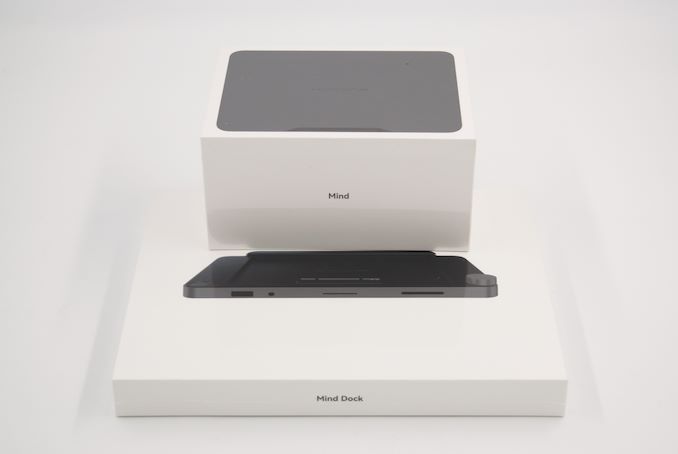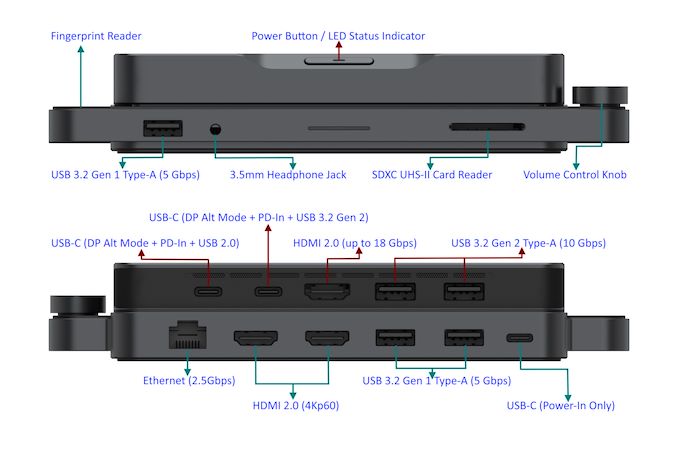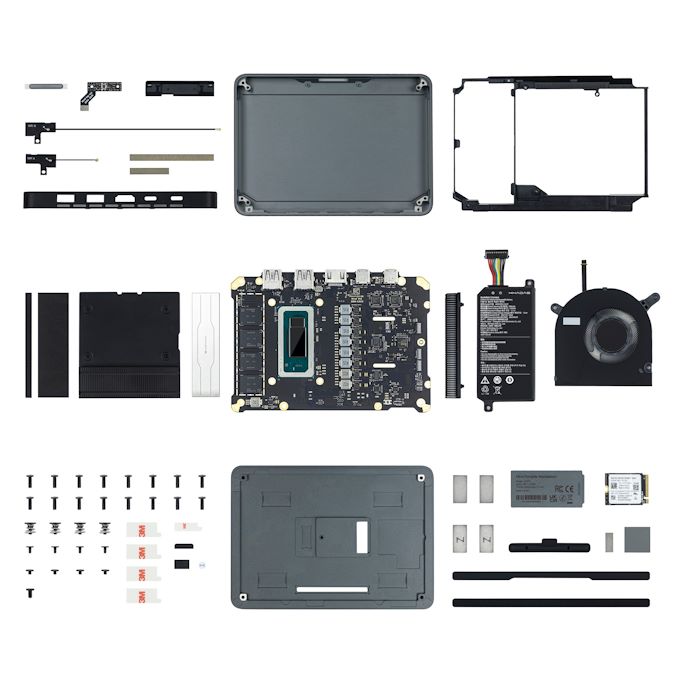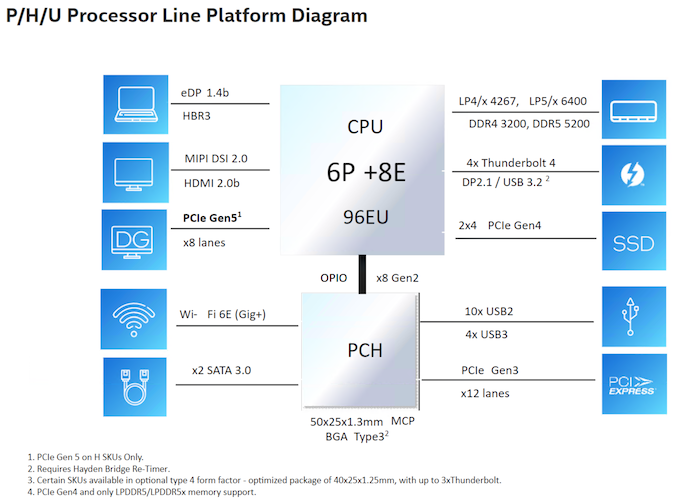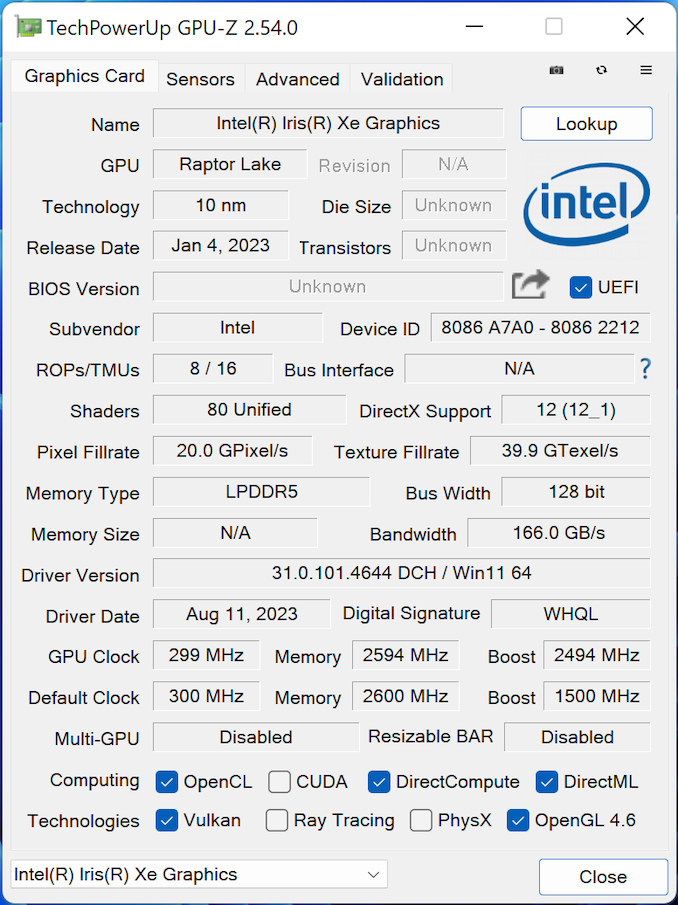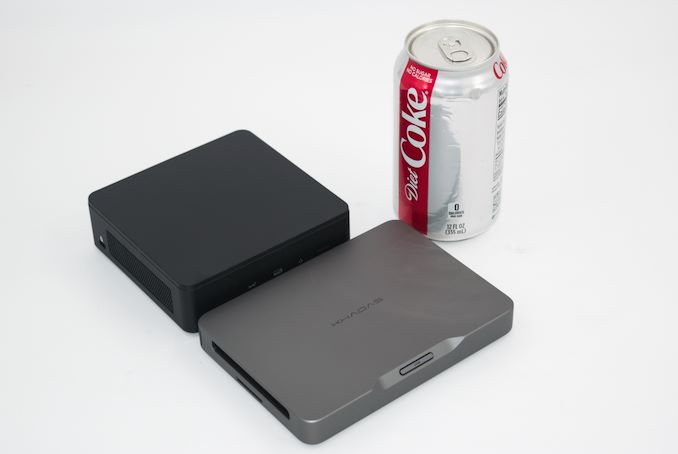
Original Link: https://www.anandtech.com/show/20038/khadas-mind-portable-modular-workstation-review-raptor-lakep-in-a-different-avatar
Khadas Mind Premium Review: Raptor Lake-P in a Modular Portable Workstation
by Ganesh T S on September 14, 2023 8:00 AM EST- Posted in
- Systems
- Intel
- Mini-PC
- Raptor Lake-P
- Khadas
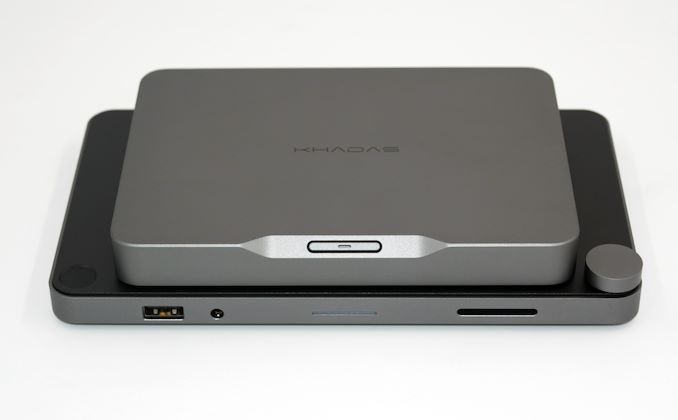
Khadas is a well-known vendor in the ARM-based single-board computer (SBC) circles with boards based on Rockchip and Amlogic SoCs. Recently, the company made its first foray into the small form-factor x86 PC space with a rather unique product family - the Khadas Mind. Unlike regular mini-PCs, the Mind is actually an ecosystem of products created with the aim of bringing a portable modular workstation to the market. Instead of relying on Thunderbolt to achieve this vision, the company has created a proprietary Mind Link connector and interface with an intent to produce a more close-knit set of products.
The main processing unit in the ecosystem is the Khadas Mind, which comes with either an Intel Core i7-1360P (Mind Premium) or an Intel Core i5-1340P (Mind Standard). Equipped with the Mind Link Connector, it can interface to a variety of peripherals such as the Mind Dock and Mind Graphics. While the former provides additional I/Os, the latter is a full-featured eGPU enclosure with a variety of ports. The main unit also includes a small battery that allows the unit to be seamlessly 'hot-plugged' into different peripherals, similar to a notebook.
Khadas sent across the Mind Premium along with the Mind Dock to provide us with an introduction to the Mind ecosystem. This review explores the performance and product experience delivered by Raptor Lake-P in an unusual package.
Introduction and Product Impressions
Advancements in processor architecture and semiconductor manufacturing have resulted in successful replacement of bulky tower desktops with miniaturized computing systems over the last decade. In parallel, notebooks have also become thinner, lighter, and very powerful. On the former front, many vendors are enjoying success with ultra-compact form-factor (UCFF) machines pioneered by Intel with the NUC product line. A few years back, Intel also started to introduce Compute Elements and even notebook platforms under the NUC tag in order to diversify beyond the original UCFF vision.
These compact machines have their limitations in terms of platform power dissipation. Addition of discrete GPUs is usually not possible with the UCFF form-factor, resulting in many use-cases still requiring bulky desktops. eGPU enclosures connected via Thunderbolt / USB4 have started to address this aspect. Notebook platforms have traditionally been limited in terms of supported screen sizes. For many business use-cases in particular, the keyboard and built-in screen lie unused, as the notebook is either docked to a bigger monitor or kept in storage. Some users adopt a thin-client model for their notebook, but multiple devices and the compulsory need for network connectivity may result in pain points associated with file syncing. Khadas has created the Mind product family as a solution to these problems.
The ecosystem consists of the main computing unit and a host of peripherals that interface using a proprietary Mind Link connector. The core computing unit is similar to that of an ultrabook's main board - compact, and limited in terms of I/O. However, the leeway over the unit's thickness (compared to a regular ultrabook) has enabled Khadas to equip the board with a vapor chamber-based cooling system. While the LPDDR5 RAM is soldered, the system comes with two M.2 2230 Gen4 x4 NVMe slots. Khadas doesn't sell barebones versions, but markets two different SKUs that come pre-installed with Windows 11 Home:
- Mind Premium: Core i7-1360P / 32GB of LPDDR5-5200 RAM / 1TB Gen4 x4 NVMe SSD
- Mind Standard: Core i5-1340P / 16GB of LPDDR5-5200 RAM / 512GB Gen4 x4 NVMe SSD
Khadas has plans for a large number of peripherals:
- Mind Dock: I/O expansion with additional network ports, video outputs, audio subsystem, and USB ports.
- Mind Graphics: eGPU enclosure with the NVIDIA RTX 4060Ti and additional I/O ports.for the gaming market.
- Mind Studio: Large touchscreen monitor with additional GPU for creative professionals.
- Mind xPlay: 2-in-1 tablet / notebook conversion kit (portable monitor with keyboard)
- Mind Talk: Conference room conversion kit
Currently, the company already has the Mind Dock ready to ship (it came in as part of our review package along with the Mind Premium), and the Mind Graphics is expected to ship in June 2024. The other peripherals are still in the planning stages.
The Mind Premium package comes with the main unit and USB-PD compliant Type-C adapter (up to 65W) and a braided Type-C cable along with it. A warranty card and a quick start guide are also included.
The gallery below presents the external industrial design of the main unit as well as the Mind Dock.
The main unit is a compact rectangular slab measuring 146mm x 105mm x 20mm, with a weight of 450g. The rounded edges and metal enclosure lend it a solid look and feel. Unfortunately, the core unit is rather anemic in terms of I/O. There are three display outputs - a HDMI port, and two Type-C ports. Either of the Type-C ports can be used to connect the power adapter, but they also support data transfer as detailed below. There are two USB 3.2 Gen 2 Type-A ports. The absence of USB4 / Thunderbolt 4 is a major letdown, though.
The Mind Dock provides wired networking support, a 3.5mm headphone jack, a SDXC UHS-II card slot and multiple USB 3.2 Gen 1 Type-A ports. Two HDMI 2.0 ports are also included. The Mind Dock also has a fingerprint reader and a volume control knob. Speakers are also built into the dock.
Khadas provided a full-blown teardown picture of the Mind Standard along with their press package.
The main unit is equipped with a Western Digital SN740 NVMe SSD, while the Samsung LPDDR5-5200 RAM chips are soldered. A 5.55Wh battery is also included - similar to a notebook platform. However, the battery is not meant to be used for regular operation in the absence of power input. Rather, it is meant to aid in hot-plugging and allowing the system to go to sleep without having to shut down in the absence of external power. Khadas promises up to 25 hours of standby in such scenarios.
The full specifications of the review sample (as tested) are summarized in the table below. We evaluate two configurations - one with just the Mind Premium, and another with the Mind Dock.
| Systems Specifications (as tested) |
||
| Khadas Mind Premium | Khadas Mind Premium + Mind Dock | |
| Processor | Intel Core i7-1360P Raptor Lake 4P + 8E / 16T, up to 5.0 GHz (P) up to 3.7 GHz (E) Intel 7, 18MB L2, Min / Max / Base TDP: 20W / 64W / 28W PL1 = 28W, PL2 = 64W |
Intel Core i7-1360P Raptor Lake 4P + 8E / 16T, up to 5.0 GHz (P) up to 3.7 GHz (E) Intel 7, 18MB L2, Min / Max / Base TDP: 20W / 64W / 28W PL1 = 28W, PL2 = 64W |
| Memory | 32GB LPDDR5-5200 Soldered 64-48-48-112 @ 5200 MHz 4x8 GB |
32GB LPDDR5-5200 Soldered 64-48-48-112 @ 5200 MHz 4x8 GB |
| Graphics | Intel Iris Xe Graphics (96EU @ 1.50 GHz) |
Intel Iris Xe Graphics (96EU @ 1.50 GHz) |
| Disk Drive(s) | Western Digital PC SN740 SDDQTQD-1T00 (1 TB; M.2 2230 PCIe 4.0 x4 NVMe;) (Western Digital 112L BiCS5 3D TLC NAND; SanDisk 20-82-10081 DRAM-less Controller) |
Western Digital PC SN740 SDDQTQD-1T00 (1 TB; M.2 2230 PCIe 4.0 x4 NVMe;) (Western Digital 112L BiCS5 3D TLC NAND; SanDisk 20-82-10081 DRAM-less Controller) |
| Networking | Intel Wi-Fi 6E AX211 (2x2 802.11ax - 2.4 Gbps) | Realtek RTL8156 2.5 GbE Controller (via Mind Link / USB) Intel Wi-Fi 6E AX211 (2x2 802.11ax - 2.4 Gbps) |
| Audio | Digital audio with bitstreaming support over HDMI | USB audio codec (via Mind Link / USB) (3.5mm audio jack in front) Digital audio with bitstreaming support over HDMI |
| Video | 1x HDMI 2.0 (Rear) 2x Display Port 1.4a over Type-C Alt-Mode (Rear) |
1x HDMI 2.0 (Rear on Main Unit, HDR Supported) 2x HDMI 2.0 (Rear on Dock, No HDR) 2x Display Port 1.4a over Type-C Alt-Mode (Rear on Main Unit) (max. 4 displays) |
| Miscellaneous I/O Ports | 2x USB 3.2 Gen 2 Type-A (Rear) 1x USB 3.2 Gen 2 Type-C (Rear, with DP Alt Mode and PD Input) 1x USB 2.0 Type-C (Rear, with DP Alt Mode and PD Input) |
2x USB 3.2 Gen 2 Type-A (Rear on Main Unit) 1x USB 3.2 Gen 2 Type-C (Rear on Main Unit, with DP Alt Mode and PD Input) 1x USB 2.0 Type-C (Rear on Main Unit, with DP Alt Mode and PD Input) 1x SDXC UHS-II Card Reader (Front on Dock) 1x USB 3.2 Gen 1 Type-A (Front on Dock) 2x USB 3.2 Gen 1 Type-A (Rear on Dock) 1x USB-C Power Input (Rear on Dock) |
| Operating System | Windows 11 Enterprise (22000.2360) | Windows 11 Enterprise (22000.2360) |
| Pricing | US $1099 (as configured, with Windows 11 Home OS) | US $1278 (as configured, with Windows 11 Home OS) |
| Full Specifications | Khadas Mnd Specifications | Khadas Mnd Specifications |
In the next section, we take a look at the system setup and follow it up with a detailed platform analysis.
Setup Notes and Platform Analysis
Our review sample of the Khadas Mind Premium came with all necessary components pre-installed along with Windows 11 Home. However, prior to setting up the system, we took some time to look into the BIOS interface. The video below presents the entire gamut of available options in the BIOS of the Khadas Mind Premium.
The main screen of the BIOS provides an overview of the hardware configuration along with the version. The 'Advanced' > 'Connectivity Configuration' section shows that the Wi-Fi / Bluetooth module uses the CNVi interface. The 'CPU Configuration' sub-section provides information about the efficiency and performance cores. It also allows cores to be selectively disabled, and hyper-threading to be turned off on the performance cores. Control over virtualization support is also available in this sub-section. The 'Power and Performance' subsection provides fine-grained control over the CPU and iGPU power consumption. By default, the system boots in 'Max Non-Turbo Performance' mode with Intel SpeedStep and Turbo Mode enabled. The iGPU render standby is enabled, and it is allowed to turbo as needed. Control over various trip points (temperatures) is available in the 'Platform Thermal Configuration' sub-section. The 'ACPI Settings' sub-section allows configuration of hibernation support and sleep behavior. System wake on alarm events can be configured in the 'RTC Alarm' sub-section. Switchable graphics configuration and setting of the active iGPU display output is also possible. The USB ports can also be controlled to prevent use of mass storage devices. Network boot support can also be configured in the 'Advanced' section. Under the 'NVMe Configuration' subsection, a self-test for the WD PC SN740 can also be triggered.
Moving on to the chipset section, VT-d can be optionally disabled. Memory chip parameters can be viewed, and the iGPU memory allocations can be configured. The PCIe links and the USB ports off the PCH can also be can also be configured in this section. The 'Security' section allows a password to be set for the BIOS interface, configuration of secure boot, and the configuration of the hardware encryption features of the WD PC SN740 NVMe SSD. The 'Boot' section allows the ordering of different boot devices, and also control over the 'Fast Boot' feature (disabled by default). The BIOS interface also allows boot overrides on a per-boot basis in the 'Save & Exit' section.
Based on the BIOS options, it is already known that the AX211 Wi-Fi card is connected to the Raptor Lake-P package via CNVi . The teardown pictures show the presence of two Analogix ANX7447 USB-PD controller chips behind the two Type-C ports in the main unit. On the upstream front, they apparently connect to the Thunderbolt ports of RPL-P, but strangely, these are restricted to USB 2.0 and USB 3.2 Gen 2 (10 Gbps) speeds without PCIe tunneling support. We connected the Mind Premium to the Mind Dock, ensured all ports were connected to different peripherals, and took a screenshot of the device layout report.
The ports on the Mind Dock all appear to be behind a USB 3.2 Gen 2 VIA Labs hub chip, with Realtek controllers behind the LAN and SD card reader. Though the Mind Link interface has an effective bandwidth of 64 Gbps (up to PCIe 4.0 x4), it appears that the Mind Dock doesn't do anything beyond 10 Gbps for data transfers. Khadas also indicated that the two display outputs on the dock are also part of the 64 Gbps budget.
Intel's platform diagram for Raptor Lake P/H/U processor lines shows a large number of connectivity options. However, the RPL-P doesn't support the x8 discrete graphics lanes. Since the Mind Link connector-exercising Mind Dock doesn't have any PCIe connectivity, it became difficult to figure out which PCIe lanes were allocated to the Mind Link interface. The specifications from Khadas had indicated that the Mind Link interface was developed to support up to 8 lanes of PCIe Gen5, but the platform constraints of RPL-P resulted in the current implementation being restricted to PCIe Gen4 x4. After a bit of back and forth with Khadas, we were informed that the M.2 2230 slot accessible from the underside of the main unit behind the magnetic cover was backed up by four Gen3 lanes from the PCH, while one of the Gen4 x4 lanes from the CPU was connected to the pre-installed SSD. The other Gen4 x4 lanes from the CPU are routed out through the Mind Link connector.
In today's review, we compare the Mind Premium as well as the Mind Premium + Mind Dock and a host of other systems based on processors with TDPs ranging from 15W to 35W. The systems do not target the same market segments, but a few key aspects lie in common, making the comparisons relevant.
| Comparative PC Configurations | ||
| Aspect | Khadas Mind Premium | |
| CPU | Intel Core i7-1360P Raptor Lake 4P + 8E / 16T, up to 5.0 GHz (P) up to 3.7 GHz (E) Intel 7, 18MB L2, Min / Max / Base TDP: 20W / 64W / 28W PL1 = 28W, PL2 = 64W |
Intel Core i7-1360P Raptor Lake 4P + 8E / 16T, up to 5.0 GHz (P) up to 3.7 GHz (E) Intel 7, 18MB L2, Min / Max / Base TDP: 20W / 64W / 28W PL1 = 28W, PL2 = 64W |
| GPU | Intel Iris Xe Graphics (96EU @ 1.50 GHz) |
Intel Iris Xe Graphics (96EU @ 1.50 GHz) |
| RAM | 32GB LPDDR5-5200 Soldered 64-48-48-112 @ 5200 MHz 4x8 GB |
32GB LPDDR5-5200 Soldered 64-48-48-112 @ 5200 MHz 4x8 GB |
| Storage | Western Digital PC SN740 SDDQTQD-1T00 (1 TB; M.2 2230 PCIe 4.0 x4 NVMe;) (Western Digital 112L BiCS5 3D TLC NAND; SanDisk 20-82-10081 DRAM-less Controller) |
Western Digital PC SN740 SDDQTQD-1T00 (1 TB; M.2 2230 PCIe 4.0 x4 NVMe;) (Western Digital 112L BiCS5 3D TLC NAND; SanDisk 20-82-10081 DRAM-less Controller) |
| Wi-Fi | Intel Wi-Fi 6E AX211 (2x2 802.11ax - 2.4 Gbps) | Intel Wi-Fi 6E AX211 (2x2 802.11ax - 2.4 Gbps) |
| Price (in USD, when built) | US $1099 (as configured, with Windows 11 Home OS) | US $1099 (as configured, with Windows 11 Home OS) |
The next few sections will deal with comparative benchmarks for the above systems.
System Performance: UL and BAPCo Benchmarks
Our 2022 Q4 update to the test suite for Windows 11-based systems carries over some of the standard benchmarks we have been using over the last several years, including UL's PCMark. New additions include BAPCo's CrossMark multi-platform benchmarking tool, as well as UL's Procyon benchmark suite.
UL PCMark 10
UL's PCMark 10 evaluates computing systems for various usage scenarios (generic / essential tasks such as web browsing and starting up applications, productivity tasks such as editing spreadsheets and documents, gaming, and digital content creation). We benchmarked select PCs with the PCMark 10 Extended profile and recorded the scores for various scenarios. These scores are heavily influenced by the CPU and GPU in the system, though the RAM and storage device also play a part. The power plan was set to Balanced for all the PCs while processing the PCMark 10 benchmark. The scores for each contributing component / use-case environment are also graphed below.
| UL PCMark 10 - Performance Scores | |||

Most of the other systems equipped with the same Core i7-1360P processor manage to outperform the Khadas Mind Premium because their size and cooling solution allows them to configure a PL1 of 40W (compared to the 28W in the Mind Premium). As a result, the system makes its appearance in the second half of the pack.
UL Procyon v2.1.544
PCMark 10 utilizes open-source software such as Libre Office and GIMP to evaluate system performance. However, many of their professional benchmark customers have been requesting evaluation with commonly-used commercial software such as Microsoft Office and Adobe applications. In order to serve their needs, UL introduced the Procyon benchmark in late 2020. There are five benchmark categories currently - Office Productivity, AI Inference, Battery Life, Photo Editing, and Video Editing. AI Inference benchmarks are available only for Android devices, while the battery life benchmark is applicable to Windows devices such as notebooks and tablets. We presents results from our processing of the other three benchmarks.
| UL Procyon - Office Productivity Scores | |||
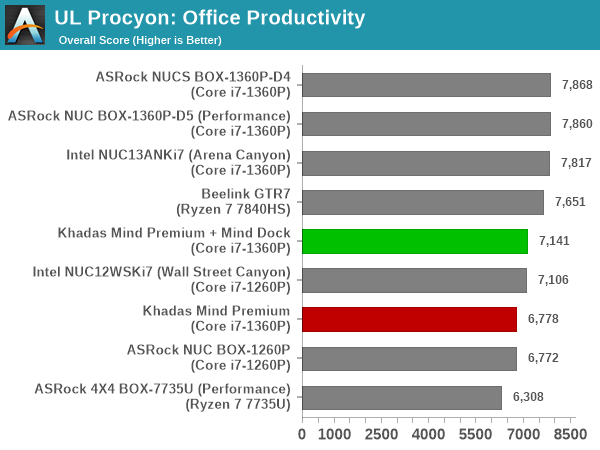
The 28W PL1 configuration dictated by the Mind Premium's form-factor means that the overall ordering is similar to what was observed for the PCMark 10 workloads.
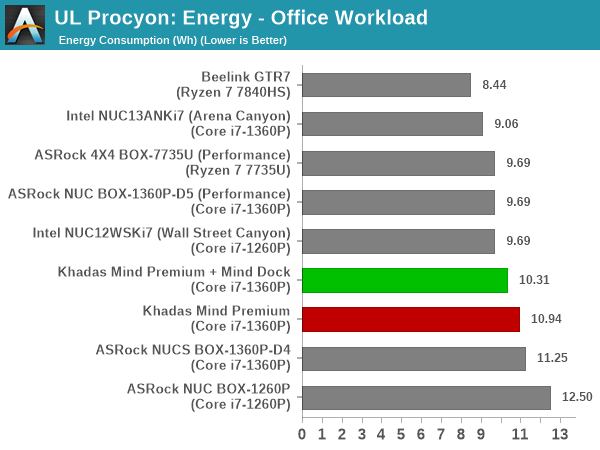
From an energy consumption viewpoint, the Mind Premium gets the job done with an energy consumption of around 10.5 Wh - well above what the Intel NUC (Arena Canyon) with the same processor (albeit, higher PL1) needed.
Moving on to the evaluation of Adobe Photoshop and Adobe Lightroom, we find the PL1 again negatively affecting the position of the Mind Premium, with the configurations being in the bottom half of the graphs.

Interestingly, the energy consumption numbers are the best of all RPL-P systems, pointing to the 28W setting being the ideal from an overall energy consumption viewpoint.

UL Procyon evaluates performance for video editing using Adobe Premier Pro.

The Mind Premium puts up a much better show here, with only the DDR5-based NUC BOX-1360P/D5 in its 40W avatar notching up a better score among RPL-P systems.

The energy consumption numbers are also reasonable, with the two configurations managing to keep themselves in the top half of the graph.
BAPCo CrossMark 1.0.1.86
BAPCo's CrossMark aims to simplify benchmark processing while still delivering scores that roughly tally with SYSmark. The main advantage is the cross-platform nature of the tool - allowing it to be run on smartphones and tablets as well.
| BAPCo CrossMark 1.0.1.86 - Sub-Category Scores | |||

The relative performance seen in the UL benchmarks translate to CrossMark also. This is not entirely unexpected, given the difference in the PL1 / PL2 settings of different systems. The comparison of CrossMark results to those from the other benchmarks above becomes interesting when the systems have similar TDPs but differing PL2 values - in such cases, CrossMark with its idle-time compression methodology may not yield realistic results (where throttling can take place when it wouldn't in the actual use-case). That is not the case here, and so the two Mind Premium configurations end up in the middle of the pack.
Workstation Performance - SPECworkstation 3.1
SFF PCs traditionally do not lend themselves to workstation duties. However, a recent trend towards miniaturized workstations has been observed. Since Khadas markets the Mind as a modular portable workstation, we decided to benchmark the system for both content creation workloads as well as professional applications.
SPECworkstation 3.1
The SPECworkstation 3.1 benchmark measures workstation performance based on a number of professional applications. It includes more than 140 tests based on 30 different workloads that exercise the CPU, graphics, I/O and memory hierarchy. These workloads fall into different categories.
- Media and Entertainment (3D animation, rendering)
- Product Development (CAD/CAM/CAE)
- Life Sciences (medical, molecular)
- Financial Services
- Energy (oil and gas)
- General Operations
- GPU Compute
Individual scores are generated for each test and a composite score for each category is calculated based on a reference machine (HP Z240 tower workstation using an Intel E3-1240 v5 CPU, an AMD Radeon Pro WX3100 GPU, 16GB of DDR4-2133, and a SanDisk 512GB SSD). Official benchmark results generated automatically by the benchmark itself are linked in the table below for the systems being compared.
| SPECworkstation 3.1 Official Results (2K) | |
| Khadas Mind Premium | Run Summary |
| Khadas Mind Premium + Mind Dock | Run Summary |
| ASRock NUC BOX-1260P | Run Summary |
| Intel NUC12WSKi7 (Wall Street Canyon) | Run Summary |
| ASRock NUC BOX-1360P-D5 (Performance) | Run Summary |
| Beelink GTR7 | Run Summary |
| ASRock 4X4 BOX-7735U (Performance) | Run Summary |
| ASRock NUCS BOX-1360P-D4 | Run Summary |
| Intel NUC13ANKi7 (Arena Canyon) | Run Summary |
Details of the tests in each category, as well as an overall comparison of the systems on a per-category basis are presented below.
Media and Entertainment
The Media and Entertainment category comprises of workloads from five distinct applications:
- The Blender workload measures system performance for content creation using the open-source Blender application. Tests include rendering of scenes of varying complexity using the OpenGL and ray-tracing renderers.
- The Handbrake workload uses the open-source Handbrake application to transcode a 4K H.264 file into a H.265 file at 4K and 2K resolutions using the CPU capabilities alone.
- The LuxRender workload benchmarks the LuxCore physically based renderer using LuxMark.
- The Maya workload uses the SPECviewperf 13 maya-05 viewset to replay traces generated using the Autodesk Maya 2017 application for 3D animation.
- The 3ds Max workload uses the SPECviewperf 13 3dsmax-06 viewset to replay traces generated by Autodesk's 3ds Max 2016 using the default Nitrous DX11 driver. The workload represents system usage for 3D modeling tasks.
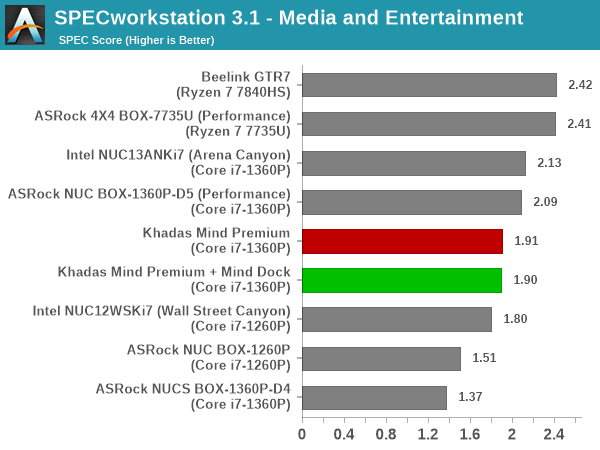
Product Development
The Product Development category comprises of eight distinct workloads:
- The Rodinia (CFD) workload benchmarks a computational fluid dynamics (CFD) algorithm.
- The WPCcfd workload benchmarks another CFD algorithm involving combustion and turbulence modeling.
- The CalculiX workload uses the Calculix finite-element analysis program to model a jet engine turbine's internal temperature.
- The Catia workload uses the catia-05 viewset from SPECviewperf 13 to replay traces generated by Dassault Systemes' CATIA V6 R2012 3D CAD application.
- The Creo workload uses the creo-02 viewset from SPECviewperf 13 to replay traces generated by PTC's Creo, a 3D CAD application.
- The NX workload uses the snx-03 viewset from SPECviewperf 13 to replay traces generated by the Siemens PLM NX 8.0 CAD/CAM/CAE application.
- The Solidworks workload uses the sw-04 viewset from SPECviewperf 13 to replay traces generated by Dassault Systemes' SolidWorks 2013 SP1 CAD/CAE application.
- The Showcase workload uses the showcase-02 viewset from SPECviewperf 13 to replay traces from Autodesk's Showcase 2013 3D visualization and presentation application
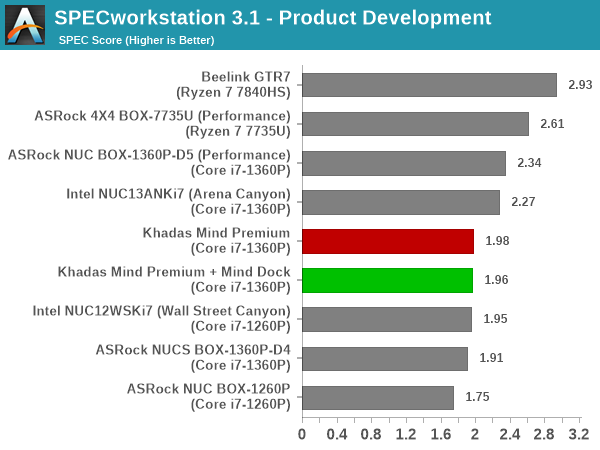
Life Sciences
The Life Sciences category comprises of four distinct test sets:
- The LAMMPS set comprises of five tests simulating different molecular properties using the LAMMPS molecular dynamics simulator.
- The NAMD set comprises of three tests simulating different molecular interactions.
- The Rodinia (Life Sciences) set comprises of four tests - the Heartwall medical imaging algorithm, the Lavamd algorithm for calculation of particle potential and relocation in a 3D space due to mutual forces, the Hotspot algorithm to estimate processor temperature with thermal simulations, and the SRAD anisotropic diffusion algorithm for denoising.
- The Medical workload uses the medical-02 viewset from SPECviewperf 13 to determine system performance for the Tuvok rendering core in the ImageVis3D volume visualization program.
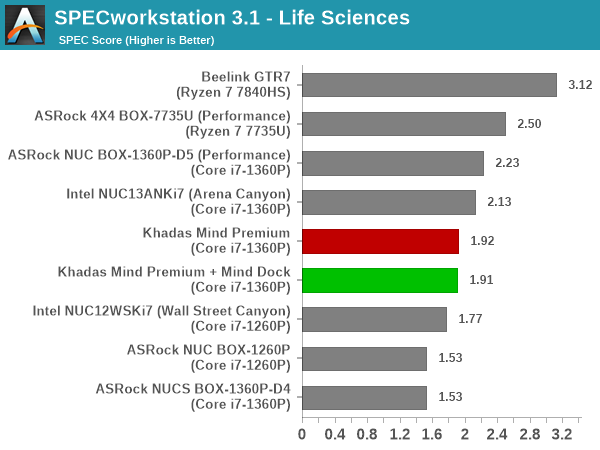
Financial Services
The Financial Services workload set benchmarks the system for three popular algorithms used in the financial services industry - the Monte Carlo probability simulation for risk assessment and forecast modeling, the Black-Scholes pricing model, and the Binomial Options pricing model.
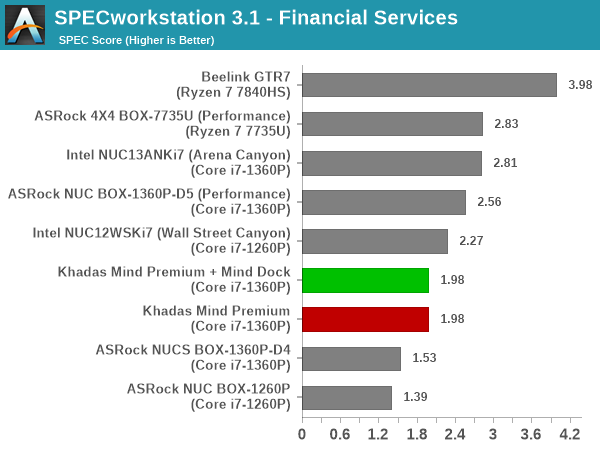
Energy
The Energy category comprises of workloads simulating various algorithms used in the oil and gas industry:
- The FFTW workload computes discrete Fourier transforms of large matrices.
- The Convolution workload computes the convolution of a random 100x100 filter on a 400 megapixel image.
- The SRMP workload processes the Surface-Related Multiples Prediction algorithm used in seismic data processing.
- The Kirchhoff Migration workload processes an algorithm to calculate the back propogation of a seismic wavefield.
- The Poisson workload takes advantage of the OpenMP multi-processing framework to solve the Poisson's equation.
- The Energy workload uses the energy-02 viewset from SPECviewperf 13 to determine system performance for the open-source OPendTec seismic visualization application.

General Operations
In the General Options category, the focus is on workloads from widely used applications in the workstation market:
- The 7zip workload represents compression and decompression operations using the open-source 7zip file archiver program.
- The Python workload benchmarks math operations using the numpy and scipy libraries along with other Python features.
- The Octave workload performs math operations using the Octave programming language used in scientific computing.
- The Storage workload evaluates the performance of the underlying storage device using transaction traces from multiple workstation applications.
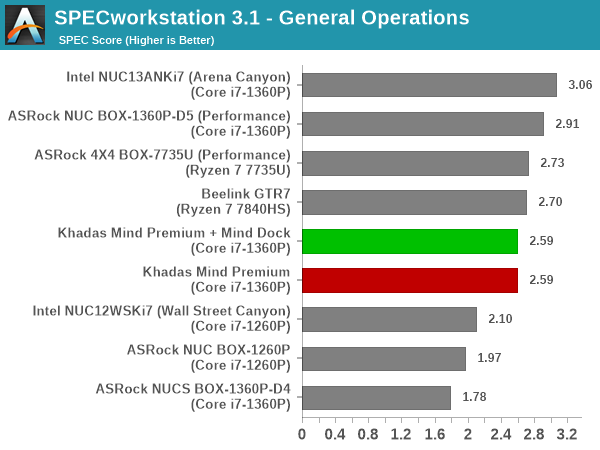
GPU Compute
In the GPU Compute category, the focus is on workloads taking advantage of the GPU compute capabilities using either OpenCL or CUDA, as applicable:
- The LuxRender benchmark is the same as the one seen in the media and entertainment category.
- The Caffe benchmark measures the performance of the Caffe deep-learning framework.
- The Folding@Home benchmark measures the performance of the system for distributed computing workloads focused on tasks such as protein folding and drug design.
We only process the OpenCL variants of the benchmark, as the CUDA version doesn't process correctly with default driver installs.
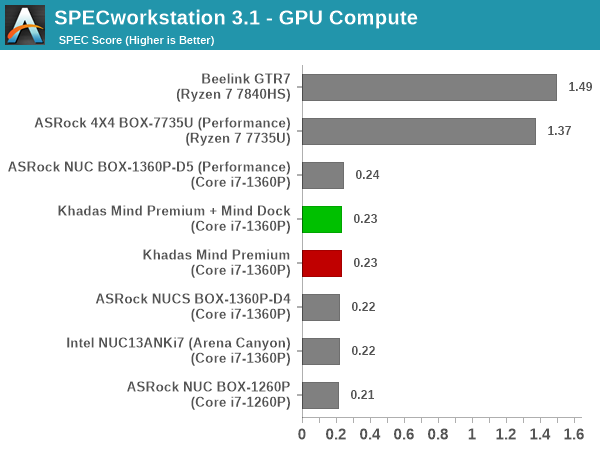
Most of the Ryzen-based systems are equipped with a large number of high-performance cores. This translates to better performance for select workloads compared to what is obtained using the hybrid scheme of performance and efficiency cores from Intel. Within the set of systems with similar number of cores, if the generation-to-generation improvements (RPL-P being better than ADL-P) are discounted, we find that the performance is essentially dependent on the available power budget. The main exception is GPU Compute - a weak point for Intel's iGPUs, as they can't complete some of the components successfully. The net result is that the Mind Premium configurations land up in the middle of the graph across all of the SPECworkstation 3.1 components.
System Performance: Miscellaneous Workloads
Standardized benchmarks such as UL's PCMark 10 and BAPCo's SYSmark take a holistic view of the system and process a wide range of workloads to arrive at a single score. Some systems are required to excel at specific tasks - so it is often helpful to see how a computer performs in specific scenarios such as rendering, transcoding, JavaScript execution (web browsing), etc. This section presents focused benchmark numbers for specific application scenarios.
3D Rendering - CINEBENCH R23
We use CINEBENCH R23 for 3D rendering evaluation. R23 provides two benchmark modes - single threaded and multi-threaded. Evaluation of different PC configurations in both supported modes provided us the following results.
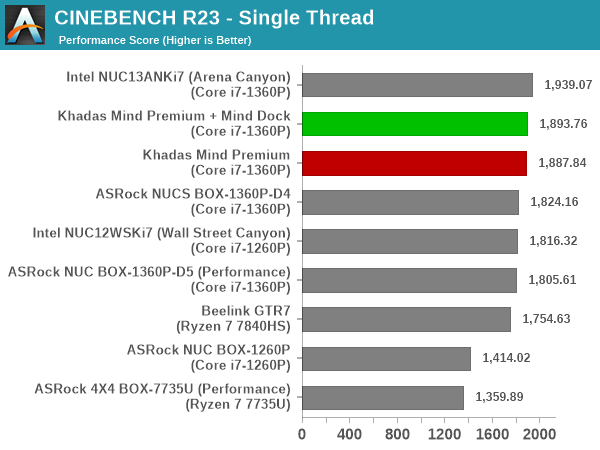
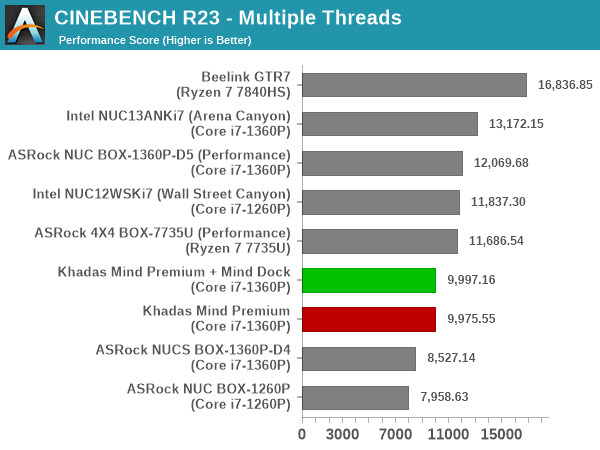
Raptor Lake-P currently holds the advantage over other processor families for single-threaded performance as it relates to CINEBENCH R23. The higher performance core counts in the Beelink GTR7 (and its 65W power budget) gives it a clear lead in the multi-threaded workload. Other systems get ordered according to their sustained power budget, with the 28W Mind Premium configurations falling behind the 40W and 35W configurations.
Transcoding: Handbrake 1.5.1
Handbrake is one of the most user-friendly open source transcoding front-ends in the market. It allows users to opt for either software-based higher quality processing or hardware-based fast processing in their transcoding jobs. Our new test suite uses the 'Tears of Steel' 4K AVC video as input and transcodes it with a quality setting of 19 to create a 720p AVC stream and a 1080p HEVC stream.
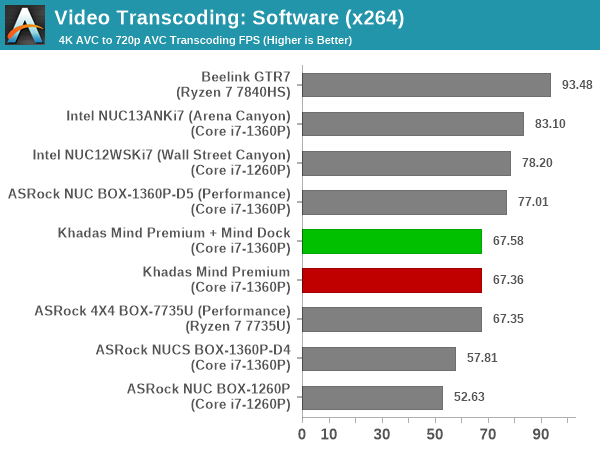
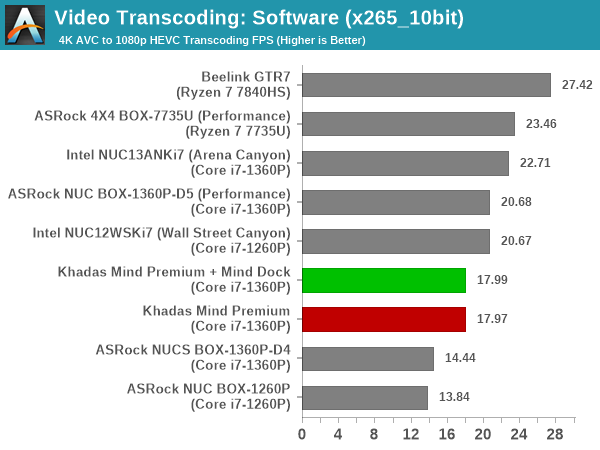
Software transcoding performance is primarily dependent on the number of available cores, assuming that the power budget is the same. Since the relative performance depends on a combination of these two factors, it is no surprise that the Beelink GTR7 with eight Zen 4 cores and a 65W power budget outperforms everything else. The Arena Canyon NUC with a 40W Core i7-1360P outperforms the 28W version in the Mind Premium configurations, with the latter ending up in bottom half of the pack.
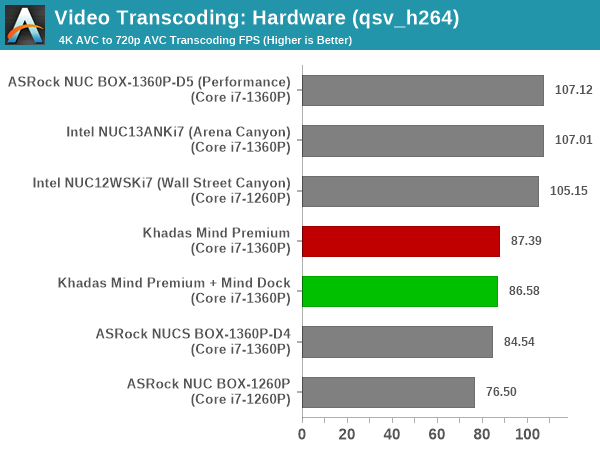
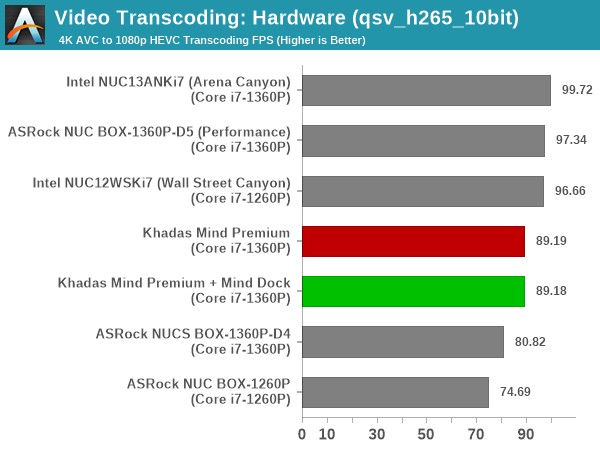
The hardware transcoding performance is simply a function of the GPU clock rate and the power budget available to maintain the sustained clocks. Higher power budgets allow the GPU to remain turbo-clocked for a longer time, and this shows in the Arena Canyon NUC (40W Core i7-1360P) being perched at the top. The 28W version in the Mind Premium configurations pushes the systems towards the middle of the pack.
Archiving: 7-Zip 21.7
The 7-Zip benchmark is carried over from our previous test suite with an update to the latest version of the open source compression / decompression software.

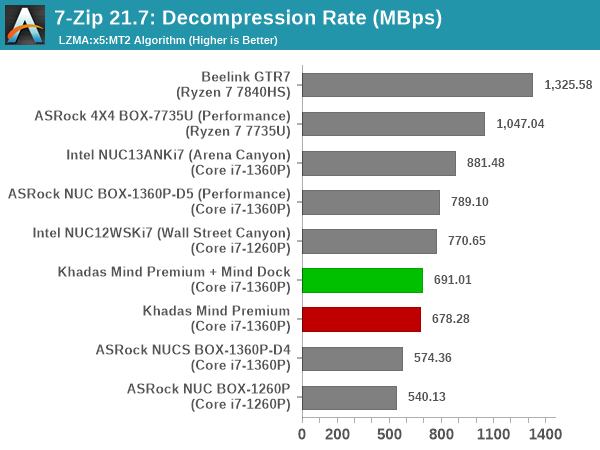
Interestingly, there is not much separating the systems based on the latest generation processors in the compression benchmark. However, the Ryzen-based systems have the edge in decompression. Within the Intel-based set, the ordering is based on the power budget. This sees the 40W configurations surpassing the 28W one used in the Mind Premium systems.
Web Browsing: JetStream, Speedometer, and Principled Technologies WebXPRT4
Web browser-based workloads have emerged as a major component of the typical home and business PC usage scenarios. For headless systems, many applications based on JavaScript are becoming relevant too. In order to evaluate systems for their JavaScript execution efficiency, we are carrying over the browser-focused benchmarks from the WebKit developers used in our notebook reviews. Hosted at BrowserBench, JetStream 2.0 benchmarks JavaScript and WebAssembly performance, while Speedometer measures web application responsiveness.
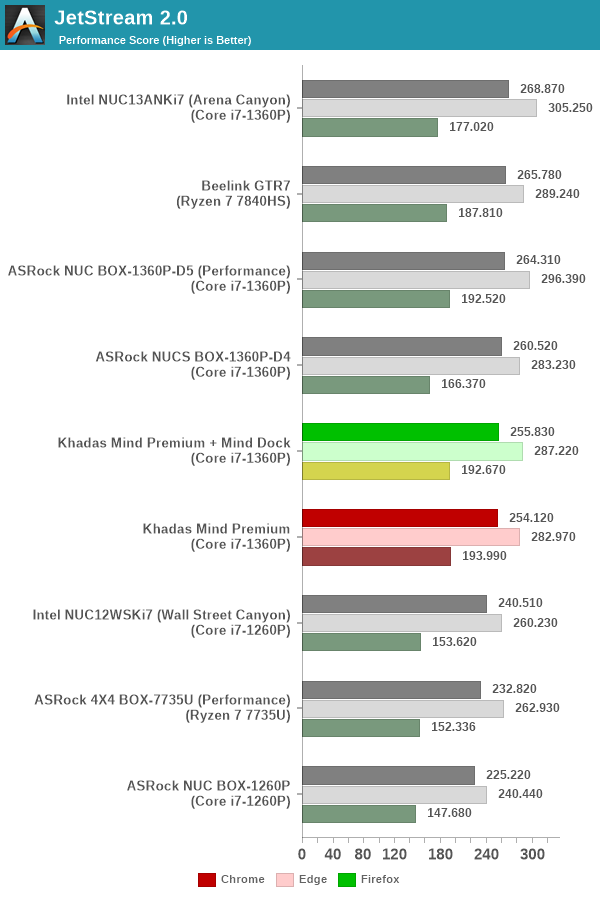
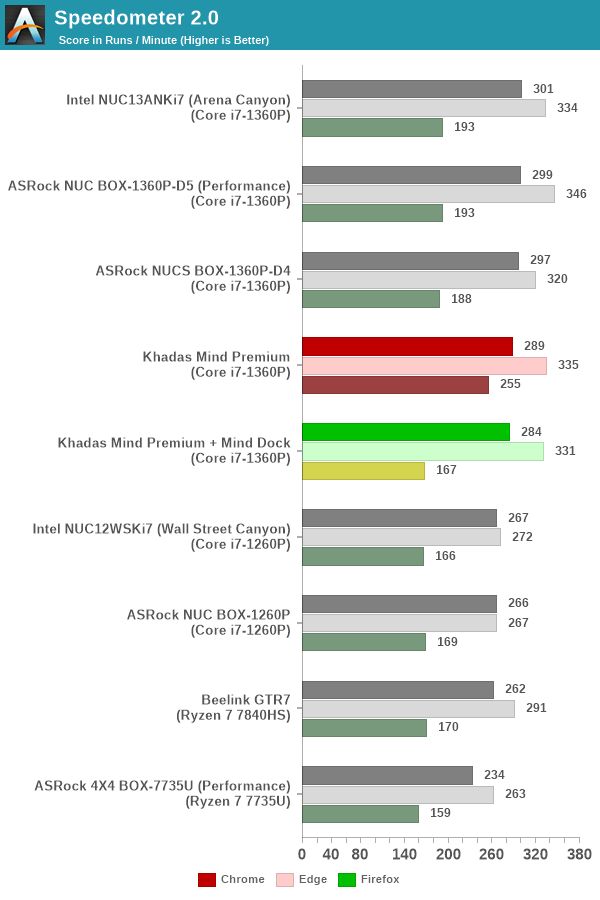
From a real-life workload perspective, we also process WebXPRT4 from Principled Technologies. WebXPRT4 benchmarks the performance of some popular JavaScript libraries that are widely used in websites.
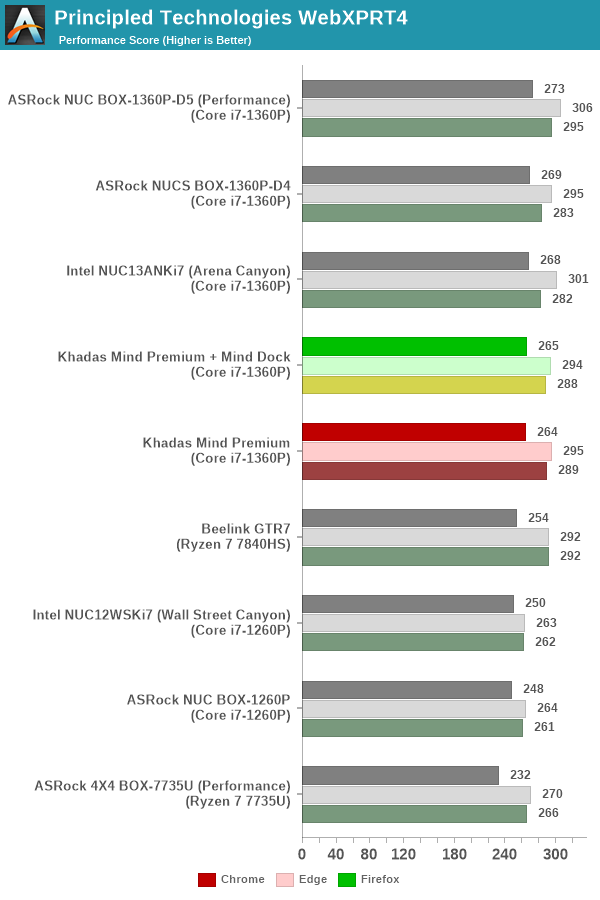
All the three workloads see the 28W Mind Premium systems making its mark in the middle of the graph - systems with higher power budgets are above it, while previous generation products appear below.
Application Startup: GIMP 2.10.30
A new addition to our systems test suite is AppTimer - a benchmark that loads up a program and determines how long it takes for it to accept user inputs. We use GIMP 2.10.30 with a 50MB multi-layered xcf file as input. What we test here is the first run as well as the cached run - normally on the first time a user loads the GIMP package from a fresh install, the system has to configure a few dozen files that remain optimized on subsequent opening. For our test we delete those configured optimized files in order to force a fresh load every second time the software is run.

As it turns out, GIMP does optimizations for every CPU thread in the system, which requires that higher thread-count processors take a lot longer to run. So the test runs quick on systems with fewer threads, however fast cores are also needed. Most of the systems have similar number of cores, and the time taken for application startup is also quite similar in both scenarios - sub-4s in the cached case, and around 8s in the cold case.
Cryptography Benchmarks
Cryptography has become an indispensable part of our interaction with computing systems. Almost all modern systems have some sort of hardware-acceleration for making cryptographic operations faster and more power efficient. In the case of IoT servers, many applications - including web server functionality and VPN - need cryptography acceleration.
BitLocker is a Windows features that encrypts entire disk volumes. While drives that offer encryption capabilities are dealt with using that feature, most legacy systems and external drives have to use the host system implementation. Windows has no direct benchmark for BitLocker. However, we cooked up a BitLocker operation sequence to determine the adeptness of the system at handling BitLocker operations. We start off with a 4.5GB RAM drive in which a 4GB VHD (virtual hard disk) is created. This VHD is then mounted, and BitLocker is enabled on the volume. Once the BitLocker encryption process gets done, BitLocker is disabled. This triggers a decryption process. The times taken to complete the encryption and decryption are recorded. This process is repeated 25 times, and the average of the last 20 iterations is graphed below.
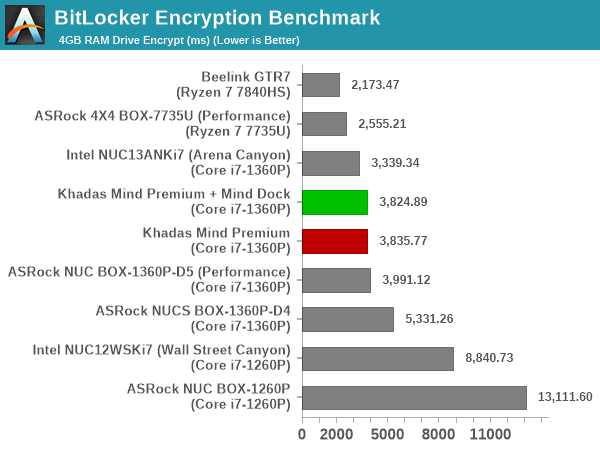
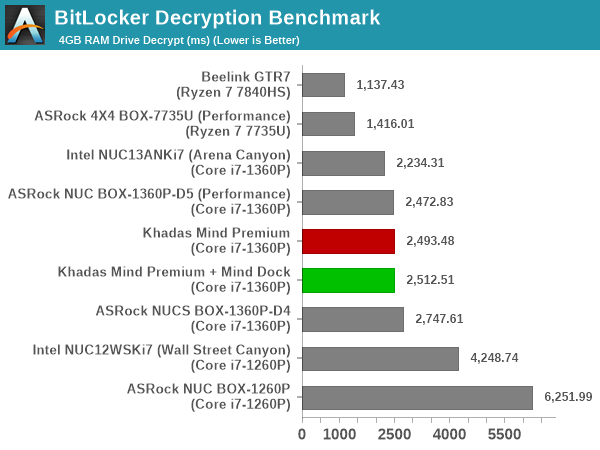
Hardware acceleration is available for the operations in all of the systems. The time taken for processing is directly dependent on the available power budget, as well as RAM speeds. The faster RAM in the 28W configuration results in a narrowed gap between the Mind Premium systems and the Arena Canyon NUC, with the latter enjoying a slight edge.
GPU Performance: Synthetic Benchmarks
Intel did not make significant changes in the integrated GPU when moving from Alder Lake to Raptor Lake. Process maturity has allowed it to clock the iGPU a bit higher, but the number of EUs remains the same as in the previous generation. GPU performance evaluation typically involved gaming workloads, and for select PCs, GPU compute. Prior to that, we wanted to take a look at the capabilities of the iGPU in the Core i7-1360P.
We have seen earlier that the performance of the Intel Iris Xe Graphics is miles ahead of previous iGPUs from both Intel and AMD. The benchmarks processed on the Mind Premium systems back up that aspect.
GFXBench
The DirectX 12-based GFXBench tests from Kishonti are cross-platform, and available all the way down to smartphones. As such, they are not very taxing for discrete GPUs and modern integrated GPUs. We processed the offscreen versions of the 'Aztec Ruins' benchmark.

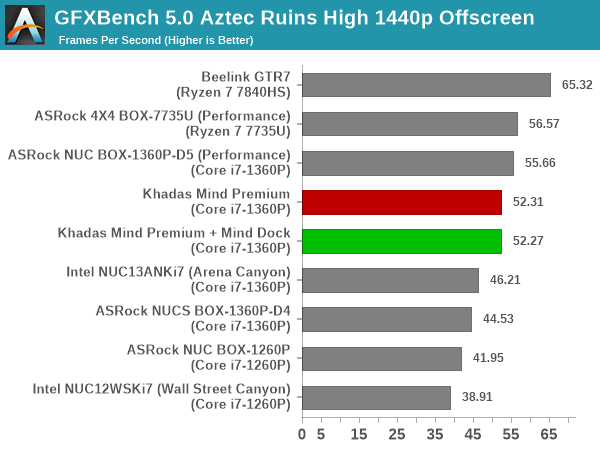
Surprisingly, the Mind Premium configurations make it to the top half of the pack. A combination of driver improvements (compared to the version used in the review of the Arena Canyon NUC) and faster RAM probably contribute to this situation.
UL 3DMark
Four different workload sets were processed in 3DMark - Fire Strike, Time Spy, Night Raid, and Wild Life.
3DMark Fire Strike
The Fire Strike benchmark has three workloads. The base version is meant for high-performance gaming PCs. It uses DirectX 11 (feature level 11) to render frames at 1920 x 1080. The Extreme version targets 1440p gaming requirements, while the Ultra version targets 4K gaming system, and renders at 3840 x 2160. The graph below presents the overall score for the Fire Strike Extreme and Fire Strike Ultra benchmark across all the systems that are being compared.
| UL 3DMark - Fire Strike Workloads | |||
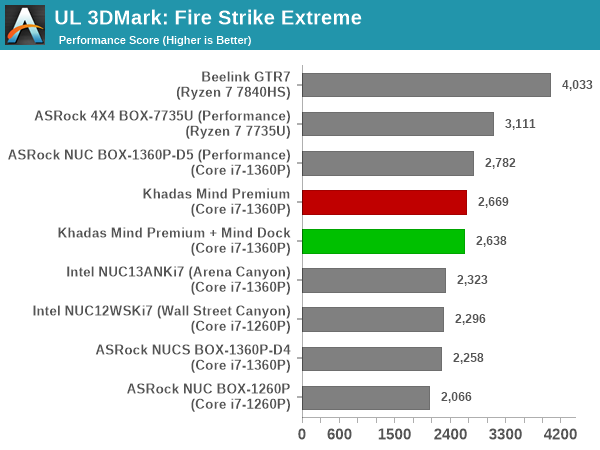
The Mind Premium makes it to the top half in these workloads, with the better iGPU in the newer Ryzen systems outperforming it. The higher power budget for the ASRock Industrial NUC BOX-1360P/D5 (40W vs 28W) gives it a slight edge among the Raptor Lake-P systems. The Arena Canyon NUC is probably held back by a combination of driver maturity and slower DDR4 RAM.
3DMark Time Spy
The Time Spy workload has two levels with different complexities. Both use DirectX 12 (feature level 11). However, the plain version targets high-performance gaming PCs with a 2560 x 1440 render resolution, while the Extreme version renders at 3840 x 2160 resolution. The graphs below present both numbers for all the systems that are being compared in this review.
| UL 3DMark - Time Spy Workloads | |||
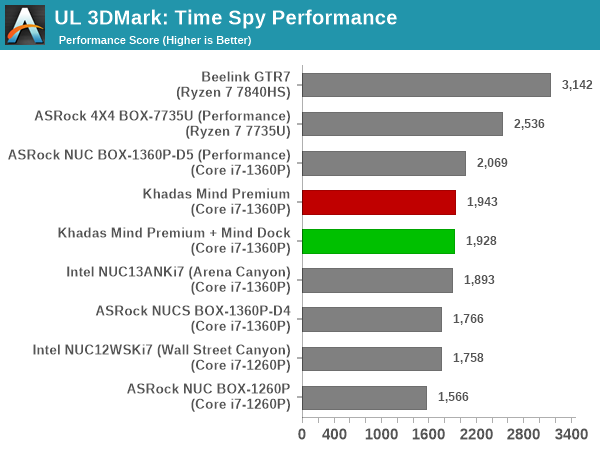
The observations made for the 3DMark Fire Strike workloads holds true for 3DMark Time Spy as well, with the Khadas Mind outperforming the Arena Canyon NUC, and being significantly behind only the RDNA2 / RDNA3 iGPU-based Ryzen systems.
3DMark Wild Life
The Wild Life workload was initially introduced as a cross-platform GPU benchmark in 2020. It renders at a 2560 x 1440 resolution using Vulkan 1.1 APIs on Windows. It is a relatively short-running test, reflective of mobile GPU usage. In mid-2021, UL released the Wild Life Extreme workload that was a more demanding version that renders at 3840 x 2160 and runs for a much longer duration reflective of typical desktop gaming usage.
| UL 3DMark - Wild Life Workloads | |||
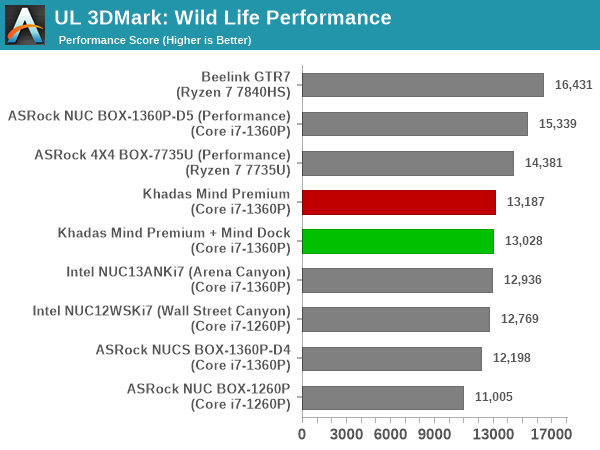
This workload is no different as well, as the Arena Canyon NUC again falls behind the Khadas Mind systems despite the higher power budget. The new Ryzen systems outperform the Khadas Mind handily, though.
3DMark Night Raid
The Night Raid workload is a DirectX 12 benchmark test. It is less demanding than Time Spy, and is optimized for integrated graphics. The graph below presents the overall score in this workload for different system configurations.
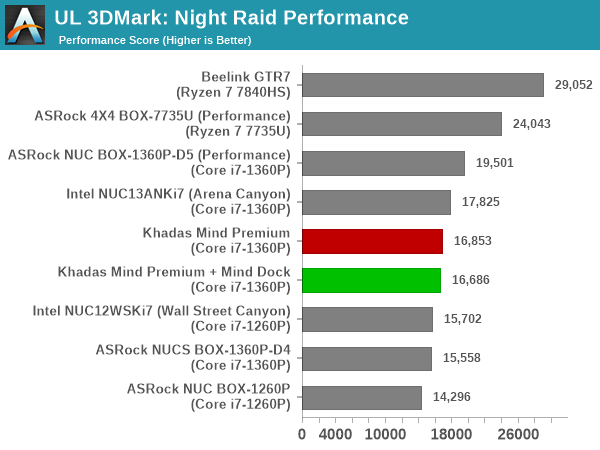
The faster RAM doesn't help the Khadas Mind in this workload, as the Arena Canyon NUC with its higher power budget manages to sneak past it in the Night Raid benchmark. The relative order remains the same for the other systems.
System Performance: Multi-Tasking
One of the key drivers of advancements in computing systems is multi-tasking. On mobile devices, this is quite lightweight - cases such as background email checks while the user is playing a mobile game are quite common. Towards optimizing user experience in those types of scenarios, mobile SoC manufacturers started integrating heterogenous CPU cores - some with high performance for demanding workloads, while others were frugal in terms of both power consumption / die area and performance. This trend is now slowly making its way into the desktop PC space.
Multi-tasking in typical PC usage is much more demanding compared to phones and tablets. Desktop OSes allow users to launch and utilize a large number of demanding programs simultaneously. Responsiveness is dictated largely by the OS scheduler allowing different tasks to move to the background. The processor is required to work closely with the OS thread scheduler to optimize performance in these cases. Keeping these aspects in mind, the evaluation of multi-tasking performance is an interesting subject to tackle.
We have augmented our systems benchmarking suite to quantitatively analyze the multi-tasking performance of various platforms. The evaluation involves triggering a ffmpeg transcoding task to transform 1716 3840x1714 frames encoded as a 24fps AVC video (Blender Project's 'Tears of Steel' 4K version) into a 1080p HEVC version in a loop. The transcoding rate is monitored continuously. One complete transcoding pass is allowed to complete before starting the first multi-tasking workload - the PCMark 10 Extended bench suite. A comparative view of the PCMark 10 scores for various scenarios is presented in the graphs below. Also available for concurrent viewing are scores in the normal case where the benchmark was processed without any concurrent load, and a graph presenting the loss in performance.
| UL PCMark 10 Load Testing - Digital Content Creation Scores | |||
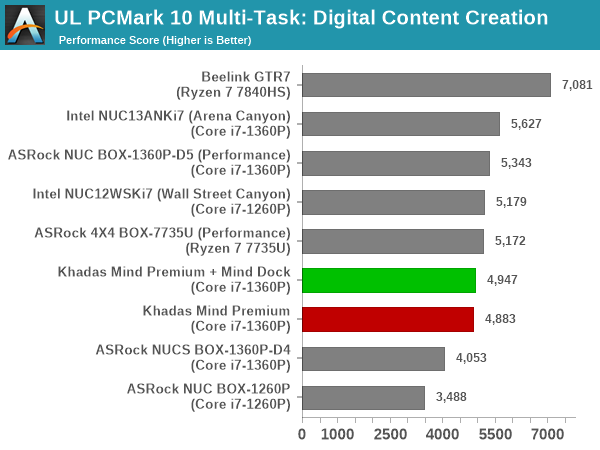
| UL PCMark 10 Load Testing - Productivity Scores | |||

| UL PCMark 10 Load Testing - Essentials Scores | |||

| UL PCMark 10 Load Testing - Gaming Scores | |||

| UL PCMark 10 Load Testing - Overall Scores | |||
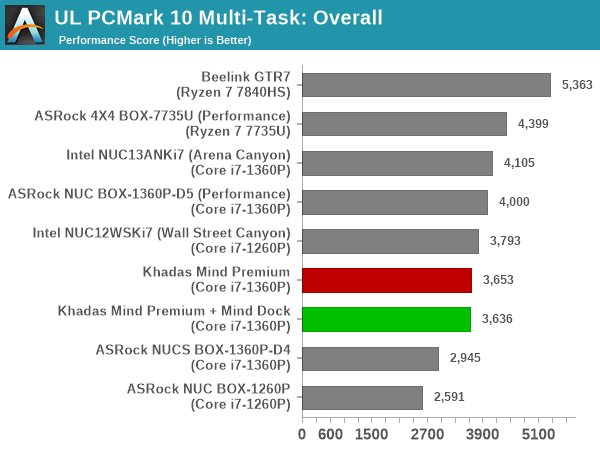
Addition of concurrent loading obviously reduces the PCMark 10 scores, but the relative ordering remain the same.
Following the completion of the PCMark 10 benchmark, a short delay is introduced prior to the processing of Principled Technologies WebXPRT4 on MS Edge. Similar to the PCMark 10 results presentation, the graph below show the scores recorded with the transcoding load active. Available for comparison are the dedicated CPU power scores and a measure of the performance loss.
| Principled Technologies WebXPRT4 Load Testing Scores (MS Edge) | |||

The relative performance numbers stay largely the same even in the presence of additional loading. Given that most of the other configurations are also based on the same hybrid processors technology, that is not a surprise.
The final workload tested as part of the multitasking evaluation routine is CINEBENCH R23.
| 3D Rendering - CINEBENCH R23 Load Testing - Single Thread Score | |||

| 3D Rendering - CINEBENCH R23 Load Testing - Multiple Thread Score | |||
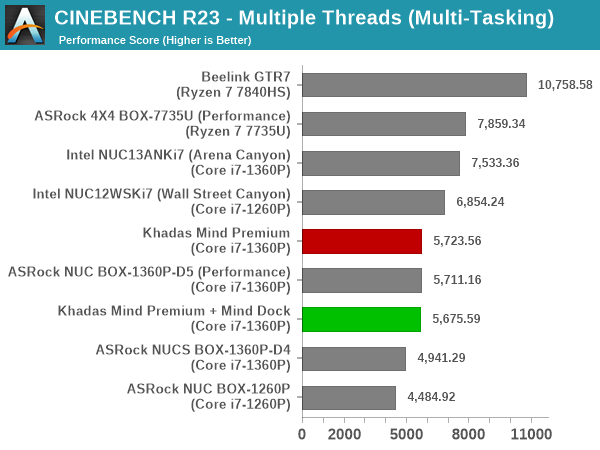
While the relative performance numbers remain the same for the multi-threaded case, the Mind Premium systems suffer greatly in the single-threaded scenario - likely due to the limited power budget compared to other systems in the mix.
After the completion of all the workloads, we let the transcoding routine run to completion. The monitored transcoding rate throughout the above evaluation routine (in terms of frames per second) is graphed below.
| ffmpeg Transcoding Rate and Processor Usage | |||

| Khadas Mind Premium (Core i7-1360P) ffmpeg Transcoding Rate (Multi-Tasking Test) | |||
| Task Segment | Transcoding Rate (FPS) | ||
| Minimum | Average | Maximum | |
| Transcode Start Pass | 3 | 11.42 | 40 |
| PCMark 10 | 0 | 10.33 | 36 |
| WebXPRT 4 | 3 | 10.41 | 20 |
| Cinebench R23 | 1 | 10.39 | 37 |
| Transcode End Pass | 3 | 11.35 | 39.5 |
| Khadas Mind Premium + Mind Dock (Core i7-1360P) ffmpeg Transcoding Rate (Multi-Tasking Test) | |||
| Task Segment | Transcoding Rate (FPS) | ||
| Minimum | Average | Maximum | |
| Transcode Start Pass | 2.5 | 11.44 | 37.5 |
| PCMark 10 | 0 | 10.32 | 35 |
| WebXPRT 4 | 2 | 10.51 | 20 |
| Cinebench R23 | 1 | 10.46 | 34.5 |
| Transcode End Pass | 2.5 | 11.47 | 39.5 |
On the positive side, the drop in transcoding frame rate for the Khadas Mind configurations is not as heavy as what was seen for systems such as the ASRock 4X4-BOX-7735U. Overall, the RPL-P systems seem to prioritize foreground task better compared to AMD systems, but with the right power budget, the end user may not even notice the aspect (the Beelink GTR7 with its 65W Ryzen 7 7840HS has a much lower delta).
HTPC Credentials
The 2022 Q4 update to our system reviews brings an updated HTPC evaluation suite for systems. After doing away with the evaluation of display refresh rate stability and Netflix streaming evaluation, the local media playback configurations have also seen a revamp. This section details each of the workloads processed on the Khadas Mind Premium as part of the HTPC suite.
YouTube Streaming Efficiency
YouTube continues to remain one of the top OTT platforms, primarily due to its free ad-supported tier. Our HTPC test suite update retains YouTube streaming efficiency evaluation as a metric of OTT support in different systems. Mystery Box's Peru 8K HDR 60FPS video is the chosen test sample. On PCs running Windows, it is recommended that HDR streaming videos be viewed using the Microsoft Edge browser after putting the desktop in HDR mode.
| YouTube Streaming Statistics | |||

The GPU in Khadas Mind Premium supports hardware decoding of VP9 Profile 2, and we see the stream encoded with that codec being played back. The streaming is perfect, thanks to the powerful GPU and hardware decoding support - the few dropped frames observed in the statistics below are due to mouse clicks involved in bringing up the overlay.
The streaming efficiency-related aspects such as GPU usage and at-wall power consumption are also graphed below for both configurations.
| YouTube Network Streaming Efficiency | |||

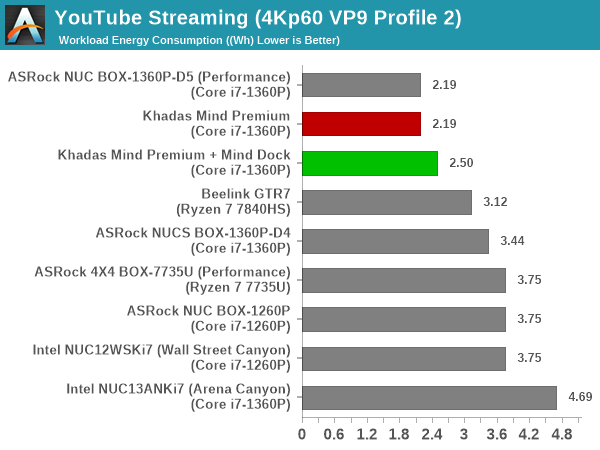
HDR playback of the YouTube stream is very energy efficient, and matches that of the ASRock Industrial NUC BOX-1360P/D5. Obviously, adding the dock does increase the energy consumption, but it is still much better than most of the other systems in the mix.
Hardware-Accelerated Encoding and Decoding
The transcoding benchmarks in the systems performance section presented results from evaluating the QuickSync encoder within Handbrake's framework. The capabilities of the decoder engine are brought out by DXVAChecker.
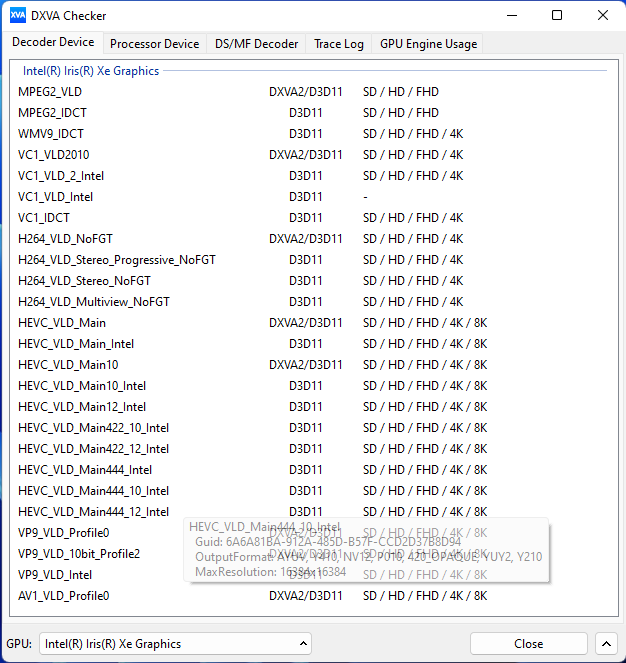
Video Decoding Hardware Acceleration in Khadas Mind Premium
The iGPU in Raptor Lake-P system supports hardware decode for a variety of codecs including AVC, JPEG, HEVC (8b and 10b, 4:2:0 and 4:4:4), and VP9 (8b and 10b, 4:2:0 and 4:4:4). AV1 decode support is also present. This is currently the most comprehensive codec support seen in the PC space.
Local Media Playback
Evaluation of local media playback and video processing is done by playing back files encompassing a range of relevant codecs, containers, resolutions, and frame rates. A note of the efficiency is also made by tracking GPU usage and power consumption of the system at the wall. Users have their own preference for the playback software / decoder / renderer, and our aim is to have numbers representative of commonly encountered scenarios. Our Q4 2022 test suite update replaces MPC-HC (in LAV filters / madVR modes) with mpv. In addition to being cross-platform and open-source, the player allows easy control via the command-line to enable different shader-based post-processing algorithms. From a benchmarking perspective, the more attractive aspect is the real-time reporting of dropped frames in an easily parseable manner. The players / configurations considered in this subsection include:
- VLC 3.0.18
- Kodi 20.2
- mpv 0.35.1 (hwdec auto, vo=gpu-next)
- mpv 0.35.1 (hwdec auto, vo=gpu-next, profile=gpu-hq)
Fourteen test streams (each of 90s duration) were played back from the local disk with an interval of 30 seconds in-between. Various metrics including GPU usage, at-wall power consumption, and total energy consumption were recorded during the course of this playback.
All our playback tests were done with the desktop HDR setting turned on. It is possible for certain system configurations to automatically turn on/off the HDR capabilities prior to the playback of a HDR video, but, we didn't take advantage of that in our testing.
| VLC Playback Efficiency | |||

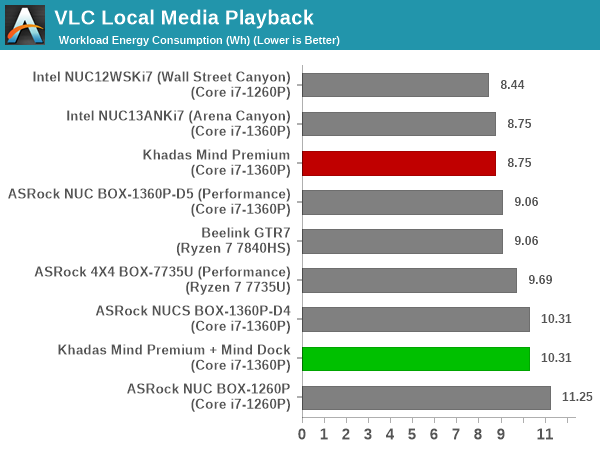
Playback was perfect for all codecs except AV1 (the CPU is not strong enough for software-only 8Kp60 decoding), and the power consumption numbers are excellent - matching that of the Arena Canyon NUC near the top of the table.
| Kodi Playback Efficiency | |||


The scenario seen with VLC is replicated in Kodi also - no proper AV1 playback, but energy numbers good enough to put the Mind Premium on par with the Arena Canyon NUC at the third place in the table.
| mpv (Default) Playback Efficiency | |||
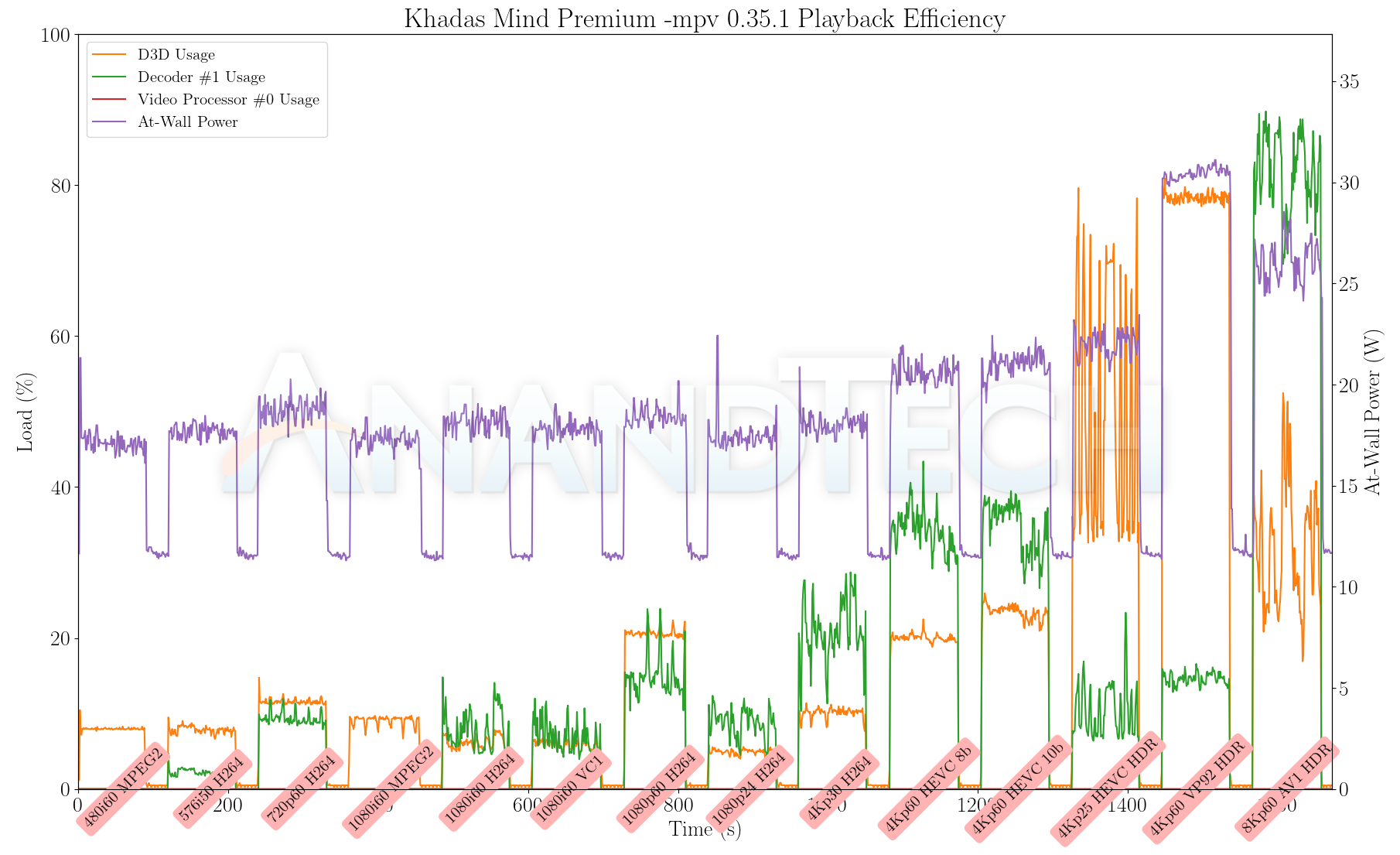

mpv playback with the gpu-next video output driver is reasonably energy efficient. We also have hardware accelerated decode for AV1. However, the playback for that clip still has issues, with more than half of the frames getting dropped in the video output (the decoder itself doesn't drop any frames).
| mpv (GPU-HQ) Playback Efficiency | |||
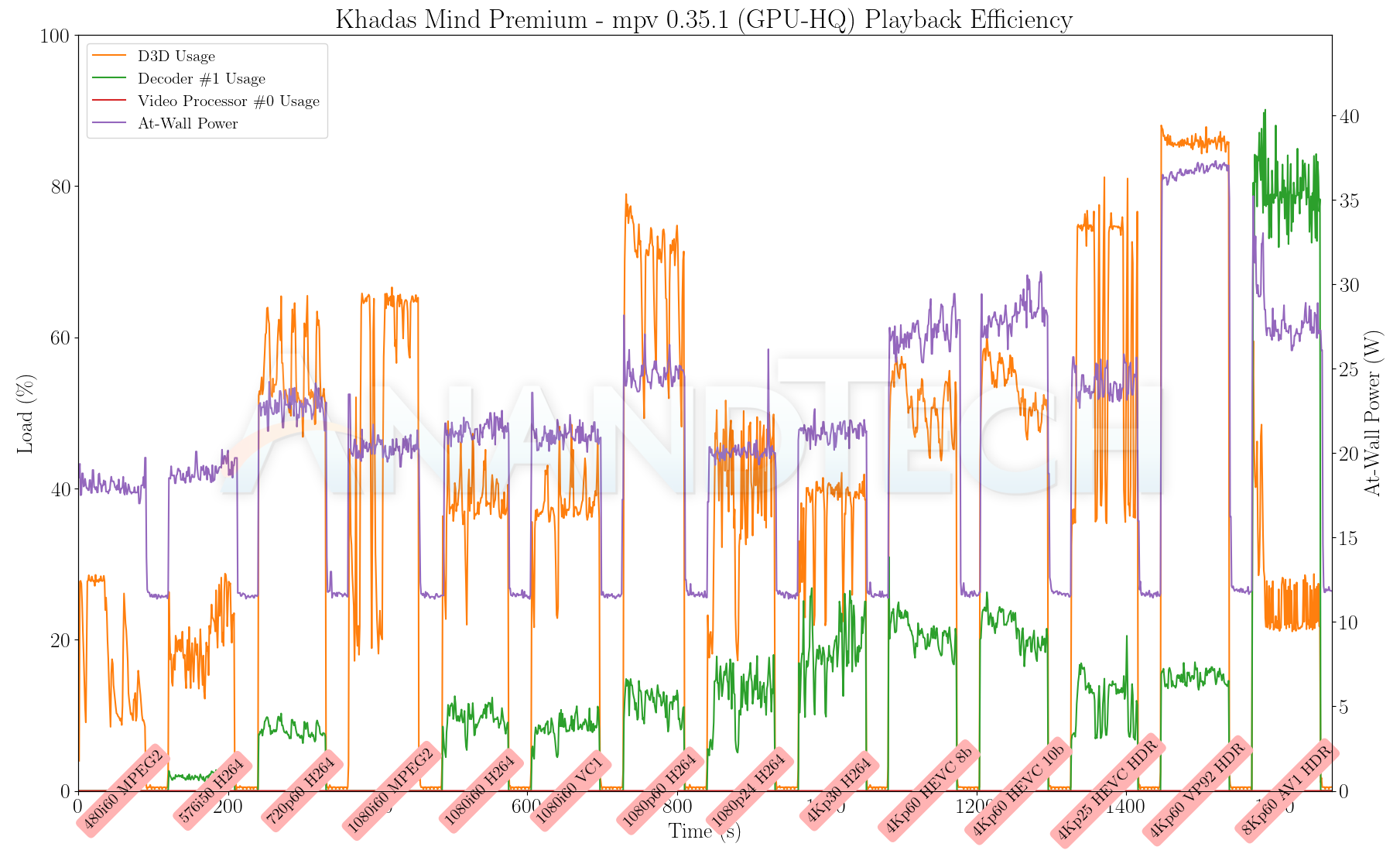

Putting additional stress on the GPU shaders for video post processing does result in increased energy consumption, but there are no dropped frames. The relative positions in the energy consumption graph remain the same. The 8Kp60 AV1 decode video output issue remains the same irrespective of the used profile.
Power Consumption and Thermal Characteristics
The power consumption at the wall was measured with a 4K display being driven through the HDMI port of the core computing unit in both configurations. In the graph below, we compare the idle and load power of the Khadas Mind Premium with other systems evaluated before. For load power consumption, we ran the AIDA64 System Stability Test with various stress components, as well as our custom stress test with Prime95 / Furmark, and noted the peak as well as idling power consumption at the wall.
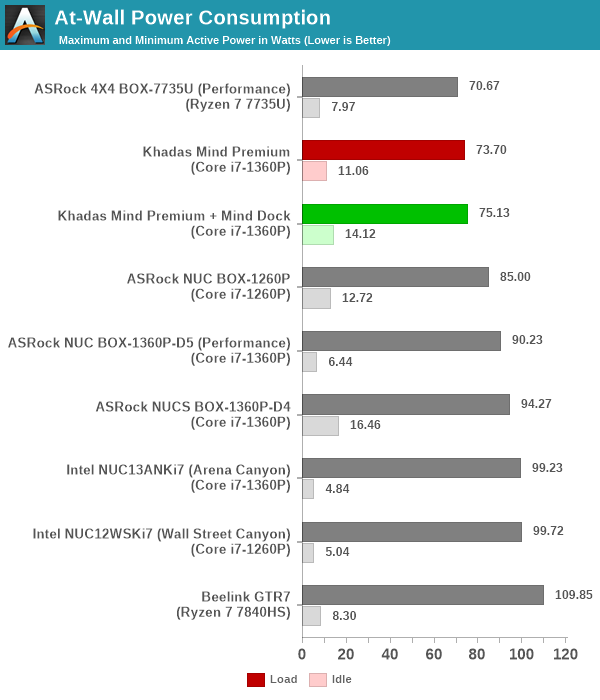
While the load numbers put the Mind Premium in the top half of the graph, the idle numbers are very disappointing. The load numbers are consistent with the TDP and suggested PL1 / PL2 values for the processors in the systems, and do not come as any surprise. While the Arena Canyon NUC idled at 4.84W, and the NUC BOX-1360P/D5 at 6.44W, the Mind Premium idles at 11.06W. Adding the dock to the mix drives that up by a few watts. It should be possible for Khadas to tweak the default BIOS settings to optimize this aspect.
Stress Testing
Our thermal stress routine is a combination of Prime95, Furmark, and Finalwire's AIDA64 System Stability Test. The following 9-step sequence is followed, starting with the system at idle:
- Start with the Prime95 stress test configured for maximum power consumption
- After 30 minutes, add Furmark GPU stress workload
- After 30 minutes, terminate the Prime95 workload
- After 30 minutes, terminate the Furmark workload and let the system idle
- After 30 minutes of idling, start the AIDA64 System Stress Test (SST) with CPU, caches, and RAM activated
- After 30 minutes, terminate the previous AIDA64 SST and start a new one with the GPU, CPU, caches, and RAM activated
- After 30 minutes, terminate the previous AIDA64 SST and start a new one with only the GPU activated
- After 30 minutes, terminate the previous AIDA64 SST and start a new one with the CPU, GPU, caches, RAM, and SSD activated
- After 30 minutes, terminate the AIDA64 SST and let the system idle for 30 minutes
Traditionally, this test used to record the clock frequencies - however, with the increasing number of cores in modern processors and fine-grained clock control, frequency information makes the graphs cluttered and doesn't contribute much to understanding the thermal performance of the system. The focus is now on the power consumption and temperature profiles to determine if throttling is in play.
| Custom Stress Test - Power Consumption Profile | |||

The cooling solution for the processor package is effective, and the package power doesn't dip below the PL1 value of 28W throughout the duration in which it is stressed. The iGPU alone seems to have a power budget of around 20W.
| Custom Stress Test - Temperature Profile | |||

On the temperature front, the package remains below 85C and there is no throttling from a package power consumption perspective. Certain parts of the SSD reach worrisome temperatures (as high as 78C) even when it is not subject to active stress.
Miscellaneous Aspects and Concluding Remarks
Networking and storage are aspects that may be of vital importance in specific PC use-cases. The Khadas Mind Premium by itself comes only with the Intel AX211 Wi-Fi 6E / Bluetooth controller. The Mind Dock adds a Realtek-based 2.5 Gbps LAN port.
On the storage side, the Khadas Mind does have support for a PCIe 4.0 x4 NVMe SSD as well as a PCIe 3.0 x4 one. The latter slot is unpopulated. Khadas uses the Western Digital WD SN740 M.2 2230 SSD as the primary drive. Cooling these SSDs within the space constraints imposed by the form-factor of the slim core computing unit is a big challenge, as shown in the SSD temperature graph in the previous section. From a benchmarking perspective, we provide results from the WPCstorage test of SPECworkstation 3.1. This benchmark replays access traces from various programs used in different verticals and compares the score against the one obtained with a 2017 SanDisk 512GB SATA SSD in the SPECworkstation 3.1 reference system.
| SPECworkstation 3.1.0 - WPCstorage SPEC Ratio Scores | |||

The graphs above present results for different verticals, as grouped by SPECworkstation 3.1. The storage workload consists of 60 subtests. Access traces from CFD solvers and programs such as Catia, Creo, and Soidworks come under 'Product Development'. Storage access traces from the NAMD and LAMMPS molecular dynamics simulator are under the 'Life Sciences' category. 'General Operations' includes access traces from 7-Zip and Mozilla programs. The 'Energy' category replays traces from the energy-02 SPECviewperf workload. The 'Media and Entertainment' vertical includes Handbrake, Maya, and 3dsmax. The overall rating puts the WD SN740 in the middle of the pack - having gotten surpassed by systems equipped with SSDs using their own DRAM for the flash translation layer (FTL). The SN740 does excel in some of the workloads such as Life Sciences and Media & Entertainment.
Closing Thoughts
As a matter of editorial policy, we do not cover crowdfunding campaigns. Some exceptions are made once in a blue moon - typically when the company behind the campaign is an established vendor using crowdfunding as a promotion tool instead of actually relying on the collected money for product development. Khadas falls under this category, as the company already has many products under the belt. The company has put up the Mind Premium / Standard, the Mind Dock, and Mind Graphics for order on a crowdfunding site, with the core computing unit and the dock shipping next month. Mind Graphics is slated to ship in June 2024.
In determining the value proposition of any product, we typically present the pros and cons before discussing the pricing. However, the Mind Premium is not a typical product. It straddles two different product categories - mini-PCs, as well as notebooks. At the same time, Khadas has plans for a number of tightly-coupled peripherals to complement the core computing unit for a variety of use-cases. Significant context is lost in the discussion if the cost is not taken into account while discussing these use-cases. The Mind Premium configuration evaluated in this piece is priced at $1099, and the Mind Dock is priced at $179. These are the retail prices (there are discounts on the crowdfunding site, but we will refrain from considering that while discussing the value proposition aspect).
At $1099, the pricing is essentially equivalent to that of an ultrabook without a screen. Similar to an ultrabook, the number of ports is limited. While we have no complaints on that front, the main issue is that all current-gen ultrabooks have full-featured Thunderbolt 4 or USB4 ports. The Mind Premium and Mind Standard fail miserably on that front. We could find no credible reason (even from the platform design viewpoint) as to why the Raptor Lake-P SoC's native Thunderbolt ports are rendered ineffective in the core computing unit. Neither Type-C port supports PCIe tunneling, with one of them restricted to USB 3.2 Gen 2 (10 Gbps) speeds and the other to USB 2.0. The display output is carried on the ports, but that is scant consolation when the ports don't support the full 40 Gbps speeds promised by the SoC. Khadas does support Thunderbolt 4 in the upcoming Mind Graphics unit, but the shipping date for that is a few quarters away. In this context, it is not clear how Khadas can justify the ultrabook premium.
The Mind Link connector interface is definitely an engineering effort worthy of appreciation. Khadas is promising support for up to 8 PCIe Gen5 lanes (an impressive 256 Gbps theoretically) through the interface - even more than what is promised by Thunderbolt 5. Due to the limitations of Raptor Lake-P, the current Mind Premium and Mind Standard only support 4 PCIe Gen4 lanes (64 Gbps). While it is not meant as a direct Thunderbolt replacement (Mind Link is a much more tightly coupled interface), the use-cases from an end-user perspective have close equivalents in the Thunderbolt ecosystem. That brings to focus two issues - the Mind Dock we have evaluated in this article does not bring out the full benefits of the Mind Link interface in the core computing unit. At best, it acts as a USB 3.2 Gen 2 (10 Gbps) dock with an Alt-DP to HDMI converter. No functionality in the dock takes advantage of the PCIe Gen4 x4 link being tunneled through. So, we have not been able to evaluate all the promised features of the Mind Link interface. The second aspect is that the Mind Link interface and protocol are proprietary. This creates a vendor lock-in, as consumers have to wait for Khadas to release peripherals taking advantage of this interface. Though Thunderbolt (with its cable-based approach) can't achieve some of the use-cases promised by Mind Link (such as the xPlay 2-in-1 peripheral), consumers have a wide variety of device choices from multiple vendors to extend the functionality of their host system.
The RAM is soldered, which may be a deal-breaker for some users. That said, 32 GB of RAM in the Mind Premium is high-end for most mini-PC use-cases. The use of a M.2 2230 SSD as the pre-installed (not easily user-accessible) storage drive is a bit puzzling. High-performance SSDs require DRAM for FTL, and most commonly available 2230 ones (including the WD SN740 used by Khadas) are DRAM-less. The user-accessible M.2 2230 slot for the secondary storage drive is perfectly acceptable.
The default BIOS settings could also do with some optimizations on the idle power consumption front - both the Arena Canyon NUC and the ASRock Industrial NUC BOX-1360P/D5 have significantly lower idling numbers despite providing much better connectivity options.
With the disappointments out of the way, it is time to focus on the positives. The build quality and industrial design of the Mind Premium as well as the Mind Dock are both impressive - among the best we have seen in the mini-PC space. The thermal solution is excellent, with core temperatures stabilizing around 80C even when the package power is sustained at 28W. Most Raptor Lake-P mini-PCs have the SoC configured for a 40W PL1 even in the UCFF space. Khadas has played it relatively safe at 28W - so the performance is a bit behind what is offered by systems such as the Arena Canyon NUC and the ASRock Industrial NUC BOX-1360P/D5. Khadas markets the Mind's core computing unit as a modular portable workstation. A 40W PL1 could have delivered better performance worthy of a workstation, but the sleek form-factor would probably throw a spanner in the works. That said, given the use-cases considered by Khadas, the form-factor is quite important. The 28W PL1 setting is a reasonable compromise.
In creating the Mind product family, Khadas has embarked on an ambitious journey. The company's vision is worthy of plaudits, and the Mind Premium / Mind Dock are able to provide users with a teaser. Ideally, the company should be shipping the Mind Graphics now to be able to convince consumers about the benefits of the Mind Link interface. By the time it arrives in mid-2024, Intel would probably be shipping new mobile processors and the current Mind Premium would be outdated. The company could have partially addressed that aspect by shipping the core computing unit with full-featured Thunderbolt 4 ports. Without that, the current unit and the Mind Dock are a tough sell despite the other impressive technical aspects of the platform. The currently available components are a good start, but we would like to see the Mind Graphics in action before forming a firm opinion about the Mind ecosystem.

